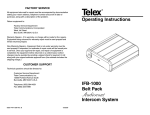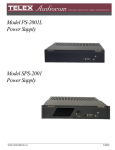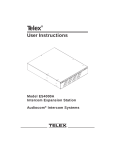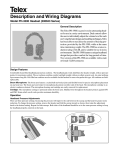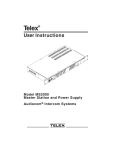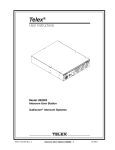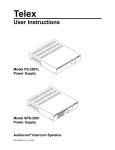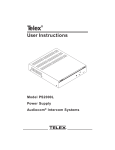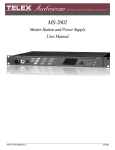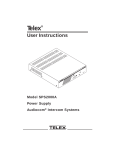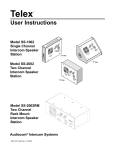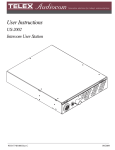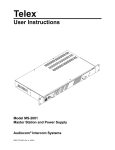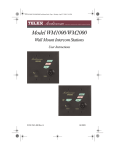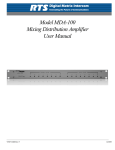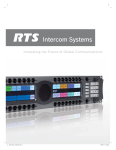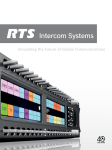Download ES-4000A User Instructions
Transcript
ES4000A Intercom Expansion Station User Instructions 9350-7551-000 Rev D 03-2010 PROPRIETARY NOTICE SHIPPING TO THE MANUFACTURER The product information and design disclosed herein were originated by and are the property of Bosch Security Systems, Inc. Bosch reserves all patent, proprietary design, manufacturing, reproduction, use and sales rights thereto, and to any article disclosed therein, except to the extent rights are expressly granted to others. All shipments of product should be made via UPS Ground, prepaid (you may request from Factory Service a different shipment method). Any shipment upgrades will be paid by the customer. The equipment should be shipped in the original packing carton. If the original carton is not available, use any suitable container that is rigid and of adequate size. If a substitute container is used, the equipment should be wrapped in paper and surrounded with at least four (4) inches of excelsior or similar shock-absorbing material. All shipments must be sent to the following address and must include the Proof of Purchase for warranty repair. Upon completion of any repair the equipment will be returned via United Parcel Service or specified shipper, collect. COPYRIGHT NOTICE Copyright 2010 by Bosch Security Systems, Inc. All rights reserved. Reproduction, in whole or in part, without prior written permission from Bosch is prohibited. WARRANTY NOTICE See the enclosed warranty card for further details. CUSTOMER SUPPORT Factory Service Department Bosch Security Systems, Inc. 8601 East Cornhusker Hwy. Lincoln, NE 68507 U.S.A. Attn: Service Technical questions should be directed to: Customer Service Department Bosch Security Systems, Inc. 12000 Portland Avenue South Burnsville, MN 55337 USA Telephone: 877-863-4169 Fax: 800-323-0498 [email protected] Technical Questions EMEA Bosch Security Systems Technical Support EMEA http://www.rtsintercoms.com/contact_main.php RETURN SHIPPING INSTRUCTIONS Customer Service Department Bosch Security Systems, Inc. (Lincoln, NE) Telephone: 402-467-5321 Fax: 402-467-3279 Factory Service: 800-553-5992 Please include a note in the box which supplies the company name, address, phone number, a person to contact regarding the repair, the type and quantity of equipment, a description of the problem and the serial number(s). FCC Statement This equipment uses and can radiate radio frequency energy that may cause interference to radio communications if not installed in accordance with this manual. The equipment has been tested and found to comply with the limits of a Class A computing device pursuant to Subpart J, Part 15, of FCC Rules which are designed to provide reasonable protection against such interference when operated in a commercial environment. Operation of this equipment in a residential area may cause interference which the user (at his own expense) will be required to correct. This product meets Electromagnetic Compatibility Directives 89/336/EEC. THE LIGHTNING FLASH AND ARROWHEAD WITHIN THE TRIANGLE IS A WARNING SIGN ALERTING YOU OF “DANGEROUS VOLTAGE” INSIDE THE PRODUCT. CAUTION: TO REDUCE THE RISK OF ELECTRIC SHOCK, DO NOT REMOVE COVER. NO USER-SERVICABLE PARTS INSIDE. REFER SERVICING TO QUALIFIED SERVICE PERSONNEL. THE EXCLAMATION POINT WITHIN THE TRIANGLE IS A WARNING SIGN ALERTING YOU OF IMPORTANT INSTRUCTIONS ACCOMPANYING THE PRODUCT SEE MARKING ON BOTTOM/BACK OF PRODUCT WARNING: APPARATUS SHALL NOT BE EXPOSED TO DRIPPING OR SPLASHING AND NO OBJECTS FILLED WITH LIQUIDS, SUCH AS VASES, SHALL BE PLACED ON THE APPARATUS. WARNING: THE MAIN POWER PLUG MUST REMAIN READILY OPERABLE CAUTION: TO REDUCE THE RISK OF ELECTRIC SHOCK, GROUNDING OF THE CENTER PIN OF THIS PLUG MUST BE MAINTAINED. WARNING: TO REDUCE THE RISK OF FIRE OR ELECTRIC SHOCK, DO NOT EXPOSE THIS APPRATUS TO RAIN OR MOISTURE. WARNING: TO PREVENT INJURY, THIS APPARATUS MUST BE SECURELY ATTACHED TO THE FLOOR/WALL/RACK IN ACCORDANCE WITH THE INSTALLATION INSTRUCTIONS. Important Safety Instructions 1. Read these instructions. 2. Keep these instructions. 3. Heed all warnings. 4. Follow all instructions. 5. Do not use this apparatus near water. 6. Clean only with dry cloth. 7. Do not block any ventilation openings. Install in accordance with the manufacturer’s instructions. 8. Do not install near any heat sources such as radiators, heat registers, stoves, or other apparatus (including amplifiers) that produce heat. 9. Do not defeat the safety purpose of the polarized or grounding-type plug. A polarized plug has two blades with one wider than the other. A grounding type plug has two blades and a third grounding prong. The wide blade or the third prong are provided for your safety. If the provided plug does not fit into your outlet, consult an electrician for replacement of the obsolete outlet. 10.Protect the power cord from being walked on or pinched particularly at plugs, convenience receptacles, and the point where they exit from the apparatus. 11.Only use attachments/accessories specified by the manufacturer. 12.Use only with the cart, stand, tripod, bracket, or table specified by the manufacturer, or sold with the apparatus. When a cart is used, use caution when moving the cart/apparatus combination to avoid injury from tip-over. 13.Unplug this apparatus during lightning storms or when unused for long periods of time. 14.Refer all servicing to qualified service personnel. Servicing is required when the apparatus has been damaged in any way, such as power-supply cord or plug is damaged, liquid has been spilled or objects have fallen into the apparatus, the apparatus has been exposed to rain or moisture, does not operate normally, or has been dropped. Table of Contents INTRODUCTION ........................................................................................................................................ 3 Introduction ...............................................................................................................................................................3 Description ................................................................................................................................................................3 Features .....................................................................................................................................................................4 Configuration Switches, Jumpers, and Sidetone Controls ........................................................................................5 INSTALLATION .......................................................................................................................................... 7 Configuration Pre-check ...........................................................................................................................................7 DIP Switches .............................................................................................................................................................7 PROGRAM INTERRUPT DIP SWITCHES .......................................................................................................................................7 AUDIOCOM CALL SEND AND RECEIVE DIP SWITCHES ..............................................................................................................8 Balanced/Unbalance Switch (SW2) ...........................................................................................................................9 DIRECT PROGRAM LISTEN ENABLE / DISABLE JUMPERS ............................................................................................................9 Sidetone Trimmers .....................................................................................................................................................9 Mounting Configurations ..........................................................................................................................................9 Connection Notes ....................................................................................................................................................13 Cables ......................................................................................................................................................................22 OPERATION AND SPECIFICATIONS .................................................................................................. 25 Power-Up ................................................................................................................................................................25 Sidetone Adjustments ...............................................................................................................................................25 Operation .................................................................................................................................................................25 Specifications ...........................................................................................................................................................26 Connector Pin Outs .................................................................................................................................................27 12-15 VDC JACK ...................................................................................................................................................................27 Addendum - Errata Sheet ........................................................................................................................................28 Notes ........................................................................................................................................................................29 CHAPTER 1 Introduction Introduction Thank you for purchasing the Audiocom ES4000A Intercom Expansion Station. We hope the many design features of this product will satisfy your intercommunication requirements for many years to come. To get the most out of the ES4000A, please take a few moments to look through this booklet before using the Intercom Expansion Station for the first time. Description The ES4000A is an Expansion Station for the US2002 User Station. It interfaces 4 additional intercom channels to the US2002, and it provides talk, listen and call buttons for the 4 additional channels. There are also 4 additional program inputs on the back of the ES4000A, 1 for each added channel. Up to 4 ES4000A Expansion Stations may be connected to the US2002 to add up to 16 channels (18 channels total). The ES4000A typically utilizes the US2002 microphone and speaker (or microphone headset) for communication with the added channels. The ES4000A also has individual speaker outputs for independent monitoring of one or more of the 4 channels, if desired. The US2002/ES4000A combination can be used as a simple, multi-channel intercom user station. In this configuration, the program inputs (and possibly the PA output of the US2002) are most likely not used, and the station operator has only talk, listen and call capability. It is also possible that advanced features of the US2002, such as Mic Kill Send, might be turned OFF. Alternatively, the US2002 / ES4000A can be used as a master station. In this application, one or more program inputs and the PA output may be connected, and the program signals to the intercom channels can be turned ON or OFF from the US2002. Additionally, the Mic Kill Send feature can be enabled, and microphones on any channels may then be turned OFF from the US2002. 3 Introduction Features FIGURE 1. ES4000A Reference View (See numbered features on next page). Intercom Talk Keys Momentary or latching (hands-free) operation possible. Call Keys Used to call intercom channels and to indicate incoming calls. Intercom Listen Keys Momentary or latching operation possible. Local Power Jack The ES4000A can be powered from the intercom channels via the CHANNEL 3-6 OUTPUTS connector (9). Alternatively, an optional PS-L wall-pack accessory may be used to power the ES4000A from an AC outlet. When power is sensed at the local power jack, the ES4000A automatically disconnects from channel power. This means more channel power is available for additional belt packs. IMPORTANT: The Local Power Jack only provides power to the ES4000A, it cannot be used to power the intercom system. 4 EXP IN and EXP OUT Connectors The EXP IN connector receives the microphone audio signal from the US2002, and it sends the monaural mix of the four ES4000A channels to the US2002 speaker or headset. The EXP OUT connector connects to the EXP IN connector of an additional ES4000A. Up to four (4) ES4000A Expansion Stations may be daisy chained with the EXP IN and EXP OUT connectors. An EXP IN/OUT cable is supplied with each ES4000A. SPEAKERS Usually, the listen mix of all four (4) ES4000A channels is sent to the US2002 speaker or headset via the EXP IN connector. Alternatively speakers may be connected to one or more of the speaker outputs of the ES4000A. BAL / UNBAL Switch This selector switch sets the ES4000A for compatibility with either Audiocom or Clear-Com channel connector pin-outs, channel power requirements, and call signaling requirements. Program Inputs Connector and Trimmers Each intercom channel has its own program input and level adjustment trimmer. For each program input, there is an internal jumper which routes the program either to the intercom channel only, or to both the intercom channel and the US2002 headset or speaker (default setting). Additionally, the program signal to the intercom channel may be turned ON or OFF via the US2002 front panel programming. There is also an intercom program interrupt DIP switch which selects either automatic program interrupt when the station operator activates a channel’s talk key, or no program interrupt during talk. The ES4000A program inputs connector may be broken out to common 3-pin XLR audio cable using an option XP-4PGM Breakout Panel. CHANNEL 3-6 OUTPUTS Connector This connector provides the intercom channel audio input/output connects, as well as operating power when the ES4000A is being powered from the intercom channels. Depending on the application, this connector can connect to either a PS4001 Power Supply, or to an XP-ES4000 Breakout Panel. Examples of both connections are provided in the wiring diagrams which follow. A channel output cable is supplied with each ES4000A Introduction Configuration Switches, Jumpers, and Sidetone Controls Customize the operation of the ES4000A to match your intercom system requirements using th configuration switches, jumpers, and sidetone controls. See “Configuration Pre-check” on page 7. FIGURE 2. Locations of configuration switches, jumpers, and sidetone controls. (Top cover removed.) 5 Introduction 6 CHAPTER 2 Installation Configuration Pre-check Before making connections, read the configuration notes that follow, and make sure that all switches and jumpers are properly set for your intended usage. Locations of configuration switches and jumpers are shown in Figure 2 on page 5. Only the DIP switches and jumpers require internal access. If access is required, remove one screw from the top cover and 3 screws from each side. DIP Switches DIP switches and their default settings are listed in Table 1 on page 8. The following paragraphs provide additional details. Program Interrupt DIP Switches Each Intercom channel has a dedicated program input. These can be used to feed background music, mix-minus audio (for broadcasting usage) etc. to the intercom channels. If external program sources will be connected to the ES4000A, you have a choice of whether or not you want the program audio to interrupt (shut off) on the intercom channel while the US2002/ ES4000A station operator is talking. 7 Installation TABLE 1. Configuration Switch Settings Switch Number Description Settings Default Setting DIP Switch SW1 (Internal) SW1-1 Program Interrupt, Ch 6 On (Closed): Enabled Off (Open): Disable Off SW1-2 Program Interrupt, Ch 5 On (Closed): Enabled Off (Open): Disable Off SW1-3 Program Interrupt, Ch 4 On (Closed): Enabled Off (Open): Disable Off SW1-4 Program Interrupt, Ch 3 On (Closed): Enabled Off (Open): Disable Off SW1-5 Audio Call Send, Ch 3a On (Closed): Enabled Off (Open): Disable On SW1-6 Audio Call Send, Ch 3a On (Closed): Enabled Off (Open): Disable On SW1-7 Audio Call Send, Ch 4a On (Closed): Enabled Off (Open): Disable On SW1-8 Audio Call Send, Ch 4a On (Closed): Enabled Off (Open): Disable On Push-button Switch SW2 (BAL - UNBAL Switch on Back Panel) Audiocom or Clear-Com operation Out: Audiocom (Balanced) In: Clear-Com (Unbalanced) Out DIP Switch SW3 (Internal) SW3-1 Audiocom Call Send, Ch5 On (Closed): Enabled Off (Open): Disabled On SW3-2a Audiocom Call Receive, Ch5a On (Closed): Enabled Off (Open): Disabled On SW3-3 Audiocom Call Send, Ch6a On (Closed): Enabled Off (Open): Disabled On SW3-4 Audiocom Call Receive, Ch6a On (Closed): Enabled Off (Open): Disabled On SW3-5a Not Used On (Closed): Enabled Off (Open): Disabled Don’t Care SW3-6a Not Used On (Closed): Enabled Off (Open): Disabled Don’t Care SW3-7a Not Used On (Closed): Enabled Off (Open): Disabled Don’t Care SW3-8a Not Used On (Closed): Enabled Off (Open): Disabled Don’t Care a a. These switches apply only when the BAL/UNBAL switch on the back panel (SW2) is set to the BAL position for Audiocom usage. When the switch is set to the UNBAL position, call send and receive are always enabled. Audiocom Call Send and Receive DIP Switches By default, all channels of the ES4000A can send and receive Audiocom call signals. You can disable call send or call receive capability for selected channels, if desired. NOTE: 8 When the BAL/UNBAL switch on the back panel is set to the UNBAL position (for use with a Clear-Com Intercom system) the call send and call receive DIP switches have no effect. Call send and call receive are always on for Clear-Com usage. Installation Balanced/Unbalance Switch (SW2) This switch must be set to the balanced (BAL) position for use with an Audiocom Intercom System. Set the switch to the unbalanced (UNBAL) position when using the US2002/ES4000A with a Clear-Com Intercom System. Direct Program Listen Enable / Disable Jumpers By default, each program input can be heard by intercom stations on the corresponding intercom channel. (This can be turned on or off for each program input via the US2002 front panel programming. See “Turning Program Inputs On and Off” in the Operation section of the US2002 User Instructions.) Additionally, all program signals can be heard directly in the US2002 speaker or headset, and each program is output at the corresponding speaker jack on the back of the ES4000A. To disable direct program listening for a program input, reset the appropriate jumper as show in Table 2 . Locations of the jumpers are shown in Figure 2 on page 5. TABLE 2. Direct Program Listen Enable / Disable Jumpers Jumper Description J15 Program 3 direct to Headset or Speaker J16 Program 4 direct to Headset or Speaker J18 Program 5 direct to Headset or Speaker J21 Program 6 direct to Headset or Speaker Settings for All Jumpers Pins 2 & 3 Shorted: Enable Pins 1 & 2 Shorted: Disable Sidetone Trimmers These trimmers are normally adjusted after all components are connected, and they can be access through the bottom cover (Figure 15 on page 25). Refer to the US2002 User Manual for the sidetone adjustment procedure. Mounting Configurations The ES4000A can be used on a desktop, or it can be rack mounted. For desktop use, install the 4 rubber feet supplied with the ES4000A. For rack mounting, use optional Audiocom RMK Rack Mount Kits (Figure 3 on page 10). Many configurations are possible when using the kits. Examples are show in Figure 4 on page 11 and Figure 5 on page 12. NOTE: When rack mounting components, you may not be able to access the sidetone trimmers after the components have been mounted. In this case, you can position the components in the rack and make all required connections. Then, adjust the sidetone trimmers before installing and tightening all rack mount screws. 9 Installation FIGURE 3. Audiocom RMK Rack Mount Kits 10 Installation Rack Mount Configuration for a 10 Channel Master Speaker Station with Minimum Power Supply Configuration. FIGURE 4. The SPS-2001 provides power for channels 1 and 2, and also provides the listening speaker for all 10 channels. A microphone must be connected to the US2002 for talk on the 10 channels. Each PS4001 provides power for 4 intercom channels and also interfaces with an ES4000A to the intercom channels. The XP-USPG interfaces 2 external program inputs to the US2002, and also interfaces the US2002 to an external PA system. Each XP-4PGM interfaces 4 external program sources to an ES4000A. Connections and further details for this configuration are shown in Figure 6. NOTE: An additional rack mount space is shown between the two PS4000 power supplies. This may be required to prevent power supply overheating when the ambient air temperature is high. 11 Installation FIGURE 5. Typical Rack Mount Configuration for a 6-Channel Master Speaker Station with Maximum Power Supply. Each channel has a separate power supply, and the SPS-2001 on channel 1 also provides the listening speaker for all 6 channels. A microphone must be connected to the US2002 for talk on the 6 channels. The XP-USPG interfaces with two (2) external program inputs to the US2002, and also interfaces the US2002 to an external PA system. The XP-4PGM interfacesfour (4) external program sources to the ES4000A. The XP-ES4000 interfaces four (4) of the PS2001L power supplies to the four (4) channels of the ES4000A. The connection between the US2002 and the ES4000A, as well as the connections of the XP-USPG and the XP-4PGM, are show in Figure 6. The power supply connections for the US2002 are shown in Figure 7. the power supply connections for the ES40000A are shown in Figure . NOTE: 12 Additional rack spaces are shown between the rows of power supplies. This may be required to prevent power supply overheating when the ambient air temperature is high. Installation Connection Notes • Typical connections for the US2002, ES4000A and various power supplies are shown starting with Figure 6. Select the configuration which most closely matches your intended usage. • The US2002 and ES4000A normally draw operating power from the intercom channel power supplies (SPS2001, PS2001L, etc.). Alternatively, you can use option PS-L Wall-pack Power Supplies. If you are using PS-L Wallpacks, connect them to the 12-15 VDC jacks on the back panels of the US2002 and ES4000A. When PS-L Wallpacks are used, the US2002 / ES4000A will not draw power from the intercom channel power supplies, leaving more power for belt packs. IMPORTANT: The PS-L power supply only provides power for the station that it is connected to. You cannot use the PS-L to power the intercom channels! • Never connect more than 1 SPS2001 PS2001L, or PS4001 Power Supply to the same intercom channel. This will cause poor audio quality and increased noise. Typically, all power supplies are located at a central location, such as a central master station. This lets the central master station operator turn off the intercom system when it is not being used. • Termination Plugs: The ES4000A is supplied with 2 termination plugs for special applications where 1 or more channels are unpowered. Figure 12 on page 20 and Figure 13 on page 21 show example of how to use these plugs. If all of your incoming channels will be powered from an SPS2001, PS2001L, or PS4001 power supply, the termination plugs are not needed. 13 Installation FIGURE 6. Central Master Station with simple power supply configuration. This 10-channel provides all of the channel power and program input connections for the intercom system. This configuration should only be used at one point in the intercom system. It is ideal for smaller intercom systems with fewer remote intercom stations. For optional power configurations that permit more stations, see Figures 7 through 10. NOTE: The SPS2001 power supply includes a speaker and is typically used for intercom listening, with a gooseneck microphone connected to the US2002 for talk-back. Alternatively, a headset with a microphone may be used. In this case, no speaker is needed, and a PS2001L power supply may therefore be used in place of the SPS2001. NOTE: For further information about cable numbers, see “Cables” on page 22 14 Installation FIGURE 7. Maximum Power Configuration for Channels 1 and 2. This power supply configuration should only be used at one point in channels 1 and 2. Typically, it is set up at the central master station. This configuration permits about twice as many remote stations on channels 1 and 2 than the configuration shown in Figure 6 on page 14. NOTE: A PS2001L may be substituted for the SPS2001 for headset-only operation. NOTE: For further information about cable numbers, see “Cables” on page 22 15 Installation FIGURE 8. Intermediate Power Configuration for Channels 3-6 (or 7-10, 11-14, etc.). This power supply configuration should only be used at one point in each group of four (4) channels. Typically, it is set up at the central master station. It permits about twice as many remote stations on the four (4) channels than is possible with the power supply configuration shown in Figure 6. NOTE: 16 For further information about cable numbers, see “Cables” on page 22. Installation TO US2000A EXP IN CONNECTOR 5 CH 3-6 ES4000A Telex SPEAKERS + - EXP IN EXP OUT 5 4 6 PROGRAM INPUTS PGM VOLUME 3 BAL-OUT UNBAL-IN LINE LEVEL 1 VRMS 12-15 VDC XP-ES4000 ® 3 4 5 CAN 3-6 OUTPUTS 6 5 BACK TO THE EXP IN CONNECTOR OF ANOTHER ES4000A 11 1 CH 6 1 CH 5 1 1 FRONT PUSH CH 4 PUSH CH 3 PUSH PUSH TO 1/2 OF REMOTE MASTER STATIONS OR BELT PACKS NOTE: For further information about cable numbers, see “Cables” on page 22 1 1 1 1 CH 6 1 ® 100-249 VAC 60/50 HZ CHN 1 CHN 2 MADE IN USA TO 1/2 OF REMOTE MASTER STATIONS OR BELT PACKS CH 6 1 CLASS 2 WIRING 1.5A 24VDC CH 5 CH 5 1 CH 4 ® 100-249 VAC 60/50 HZ CHN 1 CHN 2 1 MADE IN USA CLASS 2 WIRING 1.5A 24VDC CH 3 CH 4 ® 100-249 VAC 60/50 HZ CHN 1 CHN 2 MADE IN USA CLASS 2 WIRING 1.5A 24VDC PS2000L Power Supplies Combine / Isolate Switches set to Combine FIGURE 9. CH 3 ® 100-249 VAC 60/50 HZ CHN 1 CHN 2 MADE IN USA CLASS 2 WIRING 1.5A 24VDC Maximum Power Configuration for Channels 3-6 (or 7-10, 11-14, etc.). 17 Installation FIGURE 10. 14, etc.). Mixed Intermediate and Maximum Power Configuration for Channels 3-6 (or 7-10, 11- This power supply configuration should only be used at one point in each group of 4 channels. Typically, it is set up at the central master station. It permits about four times as many remote stations on the 4 channels than is possible with the power supply configuration shown in Figure 6. NOTE: 18 For further information about cable numbers, see “Cables” on page 22 Installation FIGURE 11. Typical remote 10-channel master station or user station. This intercom station can have the same functionality as the central master station shown in Figure 6. Alternatively, you can disable some of the advanced features, such as Mic Kill, program inputs, etc. This will limit the station’s functionality to be a common user station with multi-channel talk/listen capability. NOTE: For further information about cable numbers, see “Cables” on page 22 19 Installation System using the termination plugs supplied with the ES4000A for mixed wet- and dryline operation. FIGURE 12. In this example, channels 5 and 6 are powered from a PS2000L Power Supply (wet lines), while channels 3 and 4 are operated without power (dry lines). Any remote station connected to channel 3 or 4 must supply its own power. For example, a US2002 that is powered by a PS-L Power Supply could be connected to channels 3 and 4. The advantage of dry-line operation is that intercom stations may be operated over a much greater distance. NOTE: 20 For further information about cable numbers, see “Cables” on page 22 Installation FIGURE 13. Termination plugs used for all dry-line connection. In this example, all components use local power supplies, and no power is supplied on the intercom channels. All stations may be operated over a much greater distance than is possible when using powered channels. IMPORTANT: there should only be one termination plug used in each channel. 21 Installation NOTE: For further information about cable numbers, see “Cables” on page 22 Cables The numbers below correspond to the cable numbers in the connection drawings on the previous pages. • 1-channel intercom cable. Sold separately. Use Telex “ME” cables, below. Or, build per Figure 14 on page 23. ME-25: 25’ (7.6m) cable with Male and Female 3-pin XLR connectors. ME-50: 50’ (15.2m) cable with Male and Female 3-pin XLR connectors. ME-100: 100’ (30.4m) cable with Male and Female 3-pin XLR connectors. • 2-channel intercom cable. Sold separately. Use Telex “ME/2” cables, below. Or, build per Figure 14 on page 23. ME-25/2: 25’ (7.6m) cable with Male and Female 6-pin XLR connectors. ME-50/2: 50’ (15.2m) cable with Male and Female 6-pin XLR connectors. ME-100/2: 100’ (30.4m) cable with Male and Female 6-pin XLR connectors. • • • Y adapter cable. Sold separately. Use Telex CA-23-16. Or, build per Figure 14 on page 23. • 18” (457mm) CHANNEL OUTPUT cable, 15-pin Male Dsub to 15-pin Female Dsub. One supplied with each ES4000A. • Shielded patch cable, 9-pin Male Dsub to 9-pin Female Dsub. Customer, local purchase: available at most electronic stores. Note: All pins must be connected straight through: do not use an RS232 computer cable. • Shielded patch cable, stereo miniplug to stereo miniplug. Customer, local purchase: available at most electronic stores. • Shielded audio cable. Must have male 3-pin XLR connector at one end for connection to the XP-USPG or XP-4PGM program inputs. Pin-out for program inputs is as follows: 3ft. (0.91m) speaker cable with RCA plugs. One supplied with each SPS2000A. SPK-1000, and SPK-2000. 18” (457mm) CHANNEL OUTPUT cable, stereo miniplug to stereo miniplug. One supplied with each ES4000A. Pin 1: common Pin 2: + program input Pin 3: - program input • Shielded audio cable. Must have male 3-pin XLR connector at one end for connection to the XP-USPG output. Pin-out for PS output is as follows: Pin 1: common Pin 2: + program output Pin 3: - program output 22 Installation FIGURE 14. Audiocom Intercom cable wiring diagrams 23 Installation 24 CHAPTER 3 Operation and Specifications Power-Up The ES4000A channels power-up identically to channels 1 and 2 of the US2002. Refer to the US2002 User Instructions for all power-up information. Ch 3 Sidetone Ch 4 Sidetone Ch 5 Sidetone Ch 6 Sidetone FIGURE 15. Sidetone Trimmer Access on Bottom of ES4000A Sidetone Adjustments Use the sidetone adjustment procedure as described in the US2002 User Instructions, except substitute channel 3, channel 4, etc. The locations of the ES4000A sidetone trimmers are shown in Figure 15. Operation The ES4000A channels operate identically to channels 1 and 2 of the US2002. Refer to the US2002 User Instructions for all operating information. 25 Operation and Specifications Specifications Intercom Channel, Unbalanced Mode (BAL/UNBAL switch set to UNBAL position) General Power Requirements Voltage Output Level 1 VRMS ± 10% Phantom Power: 24VDC nominal (12 to 30VDC) Input Impedance Local Power (with PS-L Wall-pack Power Supply or equivalent): 14 to 15 VDC Bridging Impedance Current: 65mA, quiescent; 150mA maximum Dimensions 1.75” (44.5 mm) high, 8.25” (209.6mm)wide, 10.0” (250mm) deep Environmental Requirements Storage: -20°C to 80°C; 0% to 95% humidity, noncondensing Operating: -15°C to 50°C; 0% to 95% humidity, noncondensing Intercom Channels, Balanced Mode (BAL/UNBAL switch set to BAL position) Output Level: .75VRMS nominal ±10% Input Impedance 200 Ohms Bridging Impedance greater than 10,000 ohms Sidetone -40dB, 35dB, adjustable range Call Signalling Send: 20kHz ± 100Hz, 0.47VRMS ±2dB Receive: 20kHz ± 800Hz, 100 mVRMS Mic Kill Frequency Send 24kHz ± 100Hz, 0.5VRMS ±2dB Receive 24kHz ± 800Hz, 100 mVRMS Noise Contribution: less than -70dB Common Mode Rejection Ratio: 26 greater than 50dB 150 ohms 10,000 ohms ± 5% Sidetone -40dB, 35dB ± 10% adjustable range Call Signalling: Send: 11 ±2VDC Receive: 4 VDC Speaker Output Level 1.0 VRMS ±2dB (0dB nominal) Impedance 1000 ohms nominal Program Input Voltage Gain Adjustment Range (program input to channel output, with 100 mVRMS input): 25 ±3dB (2.6 VRMS maximum, unit is factory-set to 1.0 VRMS) Input Impedance: Balance 75k ohm ±10% Unbalanced 38k ohm ±10% Frequency Response EXP IN to/from Channel, EXP to/from EXP OUT, Channel to Speaker: 200Hz to 8kHz +1/-3dB Total Harmonic Distortion: Less than 0.5% Connector Pin Outs Connector Pin Outs 12-15 VDC Jack Pin 12 Pin 13 Pin 14 Pin 15 Common Channel 6 intercom audio input/output high Channel 6 intercom audio input/output low Power (30 VDC) Connector Type: 2.0mm DC jack Internal Pin: +12 to 15 VDC External Ring: Common EXP IN Jack Connector Type: 3.5mm stereo phone jack Tip: Listen Input Ring: Talk Output Sleeve: Common EXP OUT Jack Connector Type: 3.5mm stereo phone jack Tip: Talk output Ring: Listen input Sleeve: Common SPEAKER Jacks Connector Type: RCA Phono Jack Tip: Speaker Output High Sleeve: commonPROGRAM INPUTS Connector Connector Type: DB9F Female, 9-pin D-sub Pin 1: Common Pin 2: Channel 3 program in low Pin 3: Channel 4 program in low Pin 4: Channel 5 program in low Pin 5: Channel 6 program in low Pin 6: Channel 3 program in high Pin 7: Channel 4 program in high Pin 8: Channel 5 program in high Pin 9: Channel 6 program in high CHANNEL 3-6 OUTPUTS Connector Connector Type: DB15F Female, 15-pin D-sub Pin 1 Channel 3 intercom audio input/output high Pin 2 Channel 3 intercom audio input/output low Pin 3 Common Pin 4 Channel 5 intercom audio input/output high Pin 5 Channel 5 intercom audio input/output low Pin 6 Common Pin 7 Common Pin 8 Common Pin 9 Common Pin 10 Channel 4 intercom audio input/output high Pin 11 Channel 4 intercom audio input/output low 27 Operation and Specifications Addendum - Errata Sheet Document Affected: ES4000A User Instructions, Publication Number 9350-7551-000 Rev. B. Errata Number: 1 General Instructions: Use this errata with Revision A of the user instructions. This information will be included in Revision C. Page 6, item 6: The description should be 18” (457mm) CHANNEL OUTPUT cable, 15-pin Male Dsub to 15-pin Male Dsub. One supplied with each ES4000A. Pages 16-21: All cables labeled with number 6 should be labeled with number 11. The description for cable number is 11 is 18” (457mm) CHANNEL OUTPUT cable, 15-pin Male Dsub to 15-pin Male Dsub. One supplied with each ES4000A. NOTES: • When you are connecting an ES4000A to a PS4000 Power Supply, use the CHANNEL OUTPUT cable that is supplied with the ES4000A (cable 6). • When you are connecting the ES4000A to an XP-ES4000, use the CHANNEL OUTPUT cable that is supplied with the XP-ES4000 (cable 11). The CHANNEL OUTPUT cable that is supplied with the ES4000A is not used. 28 Notes Notes 29 Bosch Security Systems, Inc. 12000 Portland Avenue South Burnsville, MN 55337 U.S.A. www.boschcoommunications.com


































